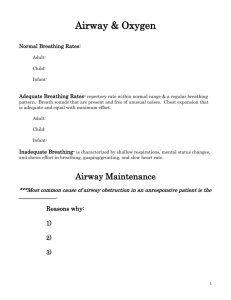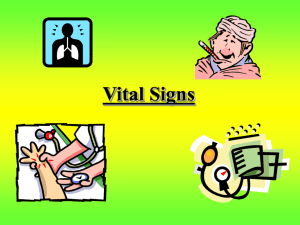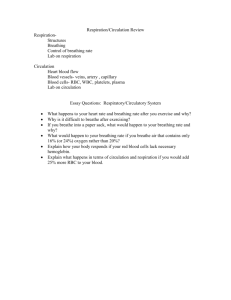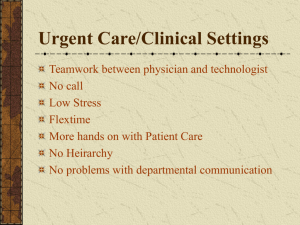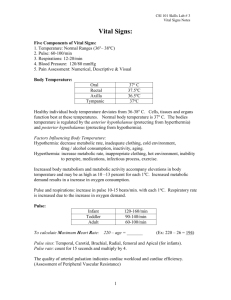File
advertisement
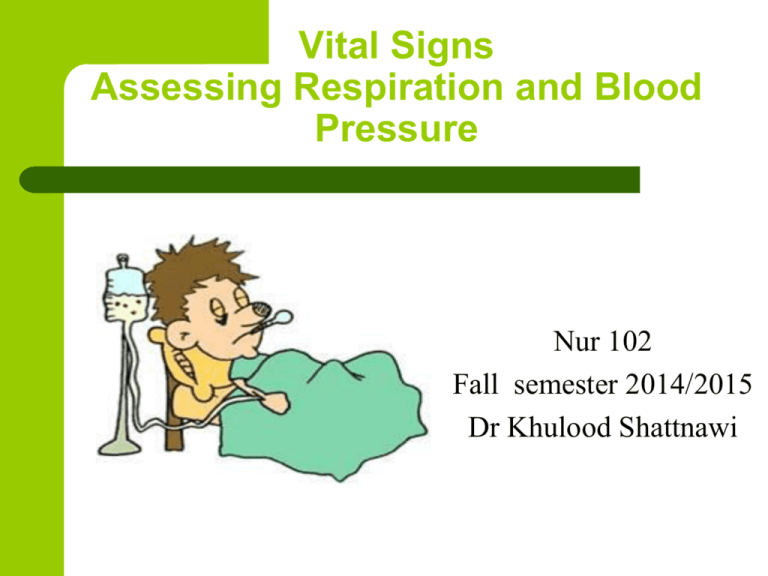
Vital Signs Assessing Respiration and Blood Pressure Nur 102 Fall semester 2014/2015 Dr Khulood Shattnawi Respiration Is the act of breathing Inhalation or inspiration: intake of air into lungs Exhalation or expiration: breathing out Ventilation: movement of air in and out of lungs Two types of breathing: – – Costal (thoracic) breathing: external intercostal muscles & accessory muscles (observed by the movement of the chest) Diaphragmatic (abdominal) breathing: contraction and relaxation of diaphragm (observed by the movement of abdomen) Inspiration in adults takes about 1-1.5 Sec. Expiration lasts 2-3 sec, twice more than inspiration. Assessing Respiration 1. 2. 3. 4. The Nurse should be aware of the following: The client’s normal breathing pattern The influence of the client’s health problems on respirations Any medications or therapies that might affect respiration The relationship of the client’s respirations to cardiovascular function Resting respirations should be assessed Assess the rate, depth, rhythm, quality and effectiveness of respiration Characteristics of Respiration 1. Rate: breath per min Eupnea: normal rate and depth (12-20 ) Bradypnea: abnormally slow respiration Tachypnea (polypnea): abnormally fast respiration. Apnea: Absence of breathing 2. Depth: Movement of chest Normal: normal Volume of air inhaled and exhaled (Tidal volume =500ml) Deep respiration: large volume of air is inhaled and exhaled, inflating most of lungs (more than 500ml) Shallow Respiration: small volume of air inhaled and exhaled inflating minimal size of lung tissue ( less than 500 ml) Hyperventilation: very deep, rapid respiration Hypoventilation: very shallow respiration 3. Respiratory rhythm: regularity of inspiration and expiration (Regular or irregular) 4. Respiratory quality or character: aspects of breathing that are different from normal breathing. Two of these aspects are: The amount of effort exert to breath: – – Normal breathing no noticeable effort. Labored breathing: need effort (substantial effort) Sound of breathing. – – Normal: silent (with no use of stethoscope) Abnormal breathing sounds (obvious wheeze to the ear) The effectiveness of respiration is measured in part by the uptake of oxygen from the air into the blood (O2 Saturation) and the release of CO2 from the blood into expired air Pulse oximeter: pulse rate and O2 saturation; the amount of Hg in arterial bld that is saturated with O2 Factors Affecting Respiration: I- Factors that increasing rate: 1. Exercise 2. Increase metabolism 3. Stress 4. Increased environmental Temp 5. Low O2 concentration at increased altitudes 6. Fever 7. Health status such as anemia II- Factors decreasing Resp. Rate: 1. Decreased environmental Temp. 2. Certain medication 3. Increased intracranial pressure 4. Body position affect amount of air that can inhaled Blood Pressure 1. 2. Arterial blood pressure: is a measure of the pressure exerted by the blood as it flows through the arteries. Systolic Pressure: Is the pressure of blood as a result of contraction of the ventricles, that is the pressure of the height of blood wave. Diastolic pressure: Is the pressure when the ventricles are at rest, then is the lower pressure present Pulse pressure: Is the difference between Diastolic and Systolic pressure (40 mmHg) but can be as high as 100 during Exercise. Pulse pressure may increase due to arteriosclerosis or decrease due to heart failure. Blood Pressure (Bp) = Systolic/Diastolic= 120/80 mmHg 120/80 Systolic Pressure Diastolic Pressure Contraction of left ventricle Top or first number Heart at rest Bottom or second number Determinant of Blood Pressure 1. 2. 3. 4. Bp is a result of many Factors: Pumping action of the heart: Determining Cardiac output (weak= ↓ Bp, strong = ↑ Bp) Peripheral Vascular Resistance: due to decrease arterioles and capillaries capacity, compliance of the arteries (elasticity), and viscosity of the blood. Blood Volume: (↓ with hemorrhage or dehydration = ↓ Bp. ↑ with rapid IV infusion = ↑Bp Blood Viscosity: Bp ↑ when blood is thick Factors affecting Blood Pressure 1. 2. 3. 4. 5. 6. 7. 8. 9. Age: the pressure rises with age Exercise: Stress: increase heart rate, cardiac output and vasoconstriction due to stimulation of sympathetic nervous system. Race: African American is more than European American Gender: female less than male but after menopause, women will have higher Bp than before Medication Obesity: predispose to hypertension Diurnal variation: Medical conditions: any condition affect CO, Blood Volume, Blood viscosity and compliance of the arteries. Hypertension 1. 2. Is a blood pressure that is persistently above normal. It is usually asymptomatic and may cause MI Two Types: Primary Hypertension: Unknown cause Secondary Hypertension: Known cause Patient considered hypertensive when Diastolic more than 90 mmHg or Systolic more than 140 mmHg for more than two readings Classification of Blood Pressure Category Systolic (mmHg) Normal < 120 Prehypertension Diastolic (mmHg) and < 80 120-139 or 80-89 Hypertension, stage 1 140-159 or 90-99 Hypertension, stage 2 > 160 or > 100 Factors associated with HTN : arteriosclerosis, inelasticity, cigarette smoking, obesity, heavy alcohol consumption, lack of physical exercise, high cholesterol level, and stress. Hypotension Is blood pressure below normal (systolic is 85110 mmHg) Orthostatic Hypotension: falling of Bp due to sitting or standing. Result from peripheral vasodilatation in which blood leaves the central body organs. Other causes: Analgesia, bleeding, sever burns, and dehydration 1. 2. 3. 4. 5. 6. When assessing orthostatic hypotension: Place patient in supine position for 10 min Record pulse and blood pressure Assist the patient to slowly sit or stand Immediately recheck the pulse and BP in the same sites as previously. Repeat the pulse and blood pressure after 3 min Record the results rises of pulse of 15-30 beats/min or a drop of BP of 20 mmHg systolic or 10 mmHg diastolic indicates orthostatic hypotension Assessing Blood Pressure Bp is measured by blood pressure cuff, sphygmomanometer and stethoscope Types of sphygmomanometer: Aneroid Mercury Electronic/ digital Cuff size The cuff should be in correct width and length for pt arm The width of the bladder should be 40% of the arm circumference The length of the bladder affect accuracy of measure ( it should cover 2\3 of the arm circumference) Sites for measuring BP Upper arm ( brachial artery) Thigh (Popliteal artery) Method of measuring BP: Direct (invasive as arterial line) Indirect ( by auscultatory or palpatory method) Bp not measured at pt arm when: The shoulder, arm or hand is injured or diseased A cast over the arm Arm with intravenous fluid Arm near mastectomy and removal of LN Arm with arteriovenous fistula Measured from thigh: When we can’t use arm When we want to compare upper and lower extremity pressure Sound heard during BP measurement called Korotkoff's sound 5 Phases of this sound Common error in assessing Bp Bladder cuff too narrow (high) Bladder cuff too wide ( low) Arm unsupported ( high) Insufficient rest before measurement ( high) Repeating Bp rapidly (high) Deflating cuff too quickly or too slowly( low SBP and high DBP) Arm above heart level (low) Assessing immediately after a meal or smoking (high)
